Are you ready to get outdoors and worried about the different varieties of snakes In Georgia? You should know that Georgia is home to many snake species, ranging from harmless non-venomous snakes to dangerous venomous snakes like the copperhead and rattlesnake.
While some snakes can be beneficial to the GA ecosystem, others cause a serious risk to humans and our furry friends. Knowing how to identify the different snake species and distinguish between venomous and non-venomous snakes is so important if you plan on doing all the best things in Georgia.
Learn the difference between venomous and non-venomous snakes, the most popular snake species found in Georgia, tips on how to identify them, and safety from afar. And tips on what to do if you encounter a snake in the wild of Georgia.
Whether you’re a hiker, a nature enthusiast, or curious about the different kinds of snakes, this Georgia snake identification guide, with photos, will help you better understand and appreciate these incredible creatures while staying safe in their habitats.
Nonvenomous vs Venomous Snakes: How to ID
There are five main ways to ID the different snakes in Georgia. These identifiers are used all over the world and ring true for all regional snakes. When out in the wild do not try to identify snakes up close, you should always keep a safe distance.
Behavior
The first way to tell if a Georgia snake is venomous is by their behavior patterns. Venomous snakes tend to be more aggressive or their territory. They are more vocal and will hiss or rattle their tails to scare their predators away. While non-venomous snakes will try to slither away instead of attacking.
Eye Type
All venomous snakes in Georgia have the same eye characterises. The dark pupil section of venomous snakes has a slit almost like a cat’s eye but more vertical. While the non-venomous snake’s pupils are almost always round.
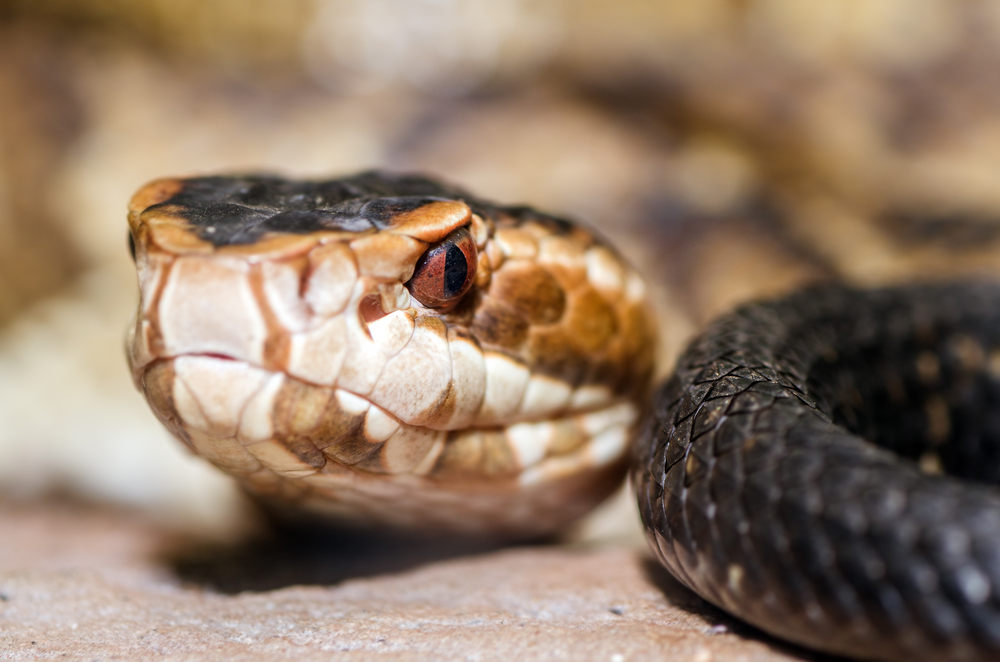
Fangs
Another surefire way to tell if a snake is venomous is if they have fangs. If you spot long, hollow fangs on a snake it is venomous and you should avoid it. The Non-venomous snakes in Georgia do not have fangs, and hopefully, you will never have to see any.
Color and Pattern
Another visual way to tell if a snake in Georgia is venomous is by the colors and patterns of their skin. The venomous ones will almost always have dark patterns and scales.
While non-venomous snakes in Georgia can be colorful and have less distinctive patterns. If you are in the wild, do not ever try to get close enough to look at the patterns of the snake.
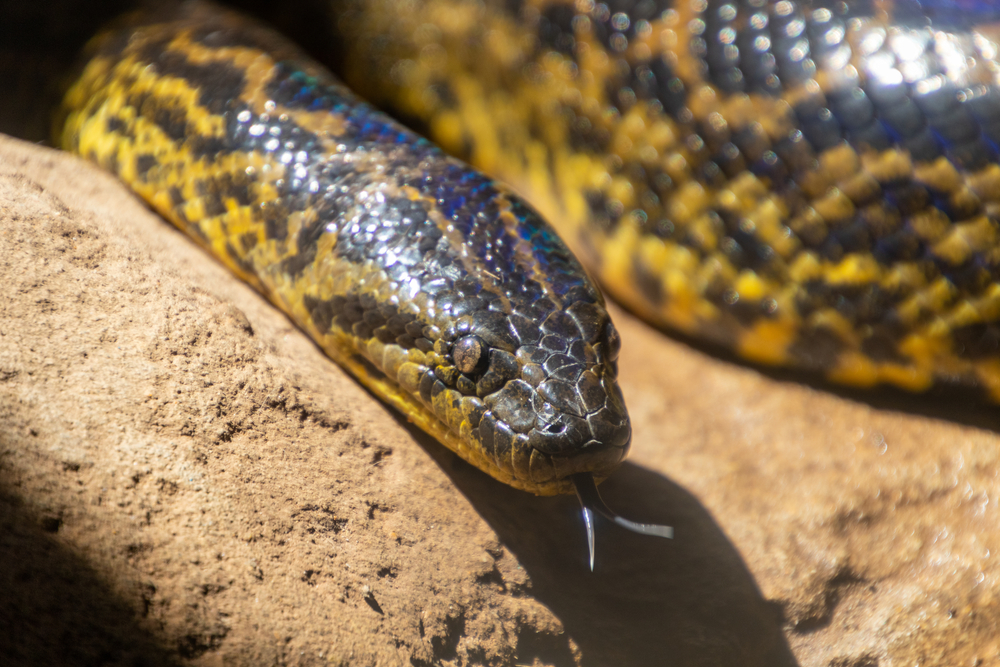
Head Shape
The head shape of snakes is a big tell on if they are dangerous to you. The heads of the venomous snakes tend to be bigger and have a more triangular shape with a long nose. Non-venomous snakes in Georgia’s heads are more square.
The snake heads are shaped differently because the venomous ones store their venom behind their eyes. There are a few exceptions to this rule, so you can never know for sure if the snake is poisonous based on just the head shape. Do not ever bend down close to the snake or pick one up in the wild, always keep your distance.
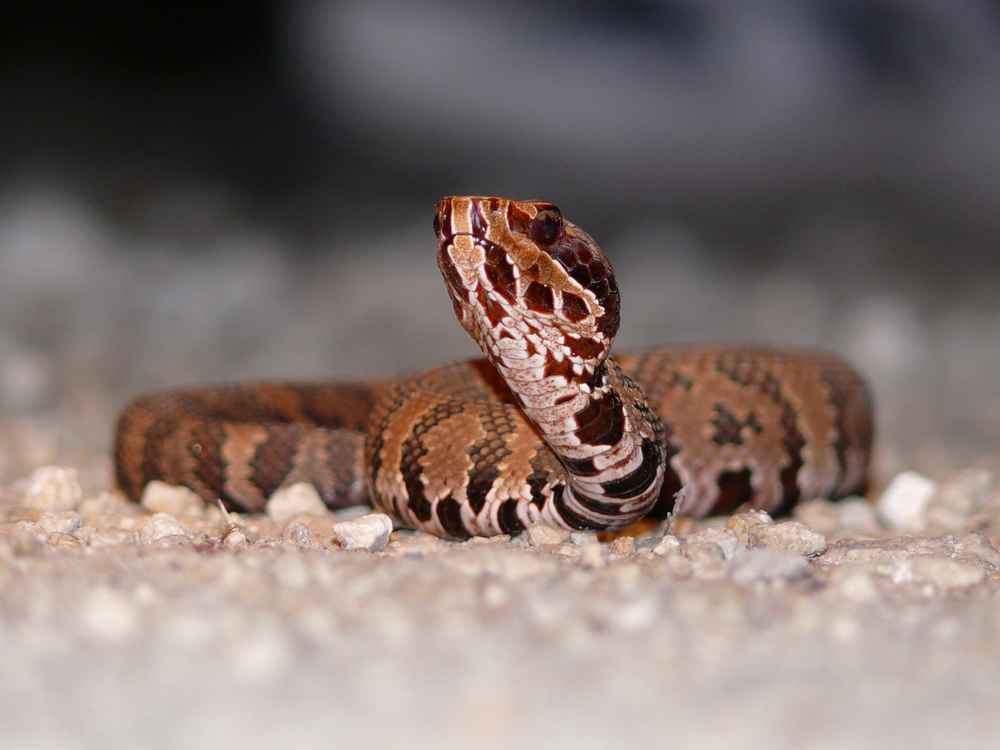
Commonly Confused Georgia Venomous and Non Venomous Snakes
Copperheads and Corn Brown Snakes in Georgia are confused with each other. This is because their patterns and colors are both dark and similar. But Corn Snakes will also have orange, reddish-brown, and gray colors. While copperheads are always dark brown and black.
Another type of non venomous snake in Georgia is the Scarlet Kingsnake snake which is confused for the venomous Eastern Coral Snake. Both of these snakes have red, yellow, and black bands. But the Scarlet Snakes has black bands in between the yellow and red, meaning it is non-venomous.
Venomous vs Poisonous snakes in Georgia
Now, it is important to learn the differences between venomous and poisonous snakes. Many people think that these words are interchangeable, but they mean two different things.
Poisonous snakes are only dangerous to humans only if it is ingested. And with venomous snakes bite they inject their venom directly into your bloodstream.
Venom from any of the venomous snakes in Georgia can cause serious bodily harm, which can lead to death. If you are bitten by a poison snake, you will experience swelling, and irritation but you will most likely be okay. Either way, when you are bitten by a snake it is good practice to call 911, or at the very least get checked out by a medical professional.
There are no poisonous snakes in Georgia, but there are quite a few different kinds of venomous snakes. The list of nonpoisonous snakes in Georgia is much longer than the venomous kind.
What to Do if you Encounter a Venomous Georgia Snake
The best thing to do if you encounter a venomous snake in Georgia is to remain as calm as you can.
Do not move towards the snake at all, respect their space.
Slowly move out of the strike zone of the snake.
Do not ever pick up a snake, even if you think it is non-venomous.
Move slowly out of the area and get to safety.
If the snake is not in its natural habitat or a place that is a high-traffic area for people then you should call your local animal control and let them know to come to investigate.
Venomous Snakes in Georgia
There are 4 species of venomous snakes of Georgia. They are the Copperhead, Rattlesnake, Cottonmouth, and Coral Snake. There are three different species of rattlesnakes throughout the state and are especially in The Coastal Plain region. This is the southern and southeastern sections of Georgia, including big cities like Savannah and Brunswick.
Take a look through all the pictures of Georgia snakes below to get a better idea of what these different types of venomous snakes look like, and where they like to live.
Copperhead
The copperheads of GA are usually dark in color with a base color of brown or black. Their favorite habitat is semi-aquatic, which means areas like swamps, marshes, or streams. But, Copperheads are can live in wooden areas with a nearby water source.
They are aggressive and like to stand their ground when confronted. If you ever think you spotted a copperhead you want to be cautious and get out of the area, safely and fast.
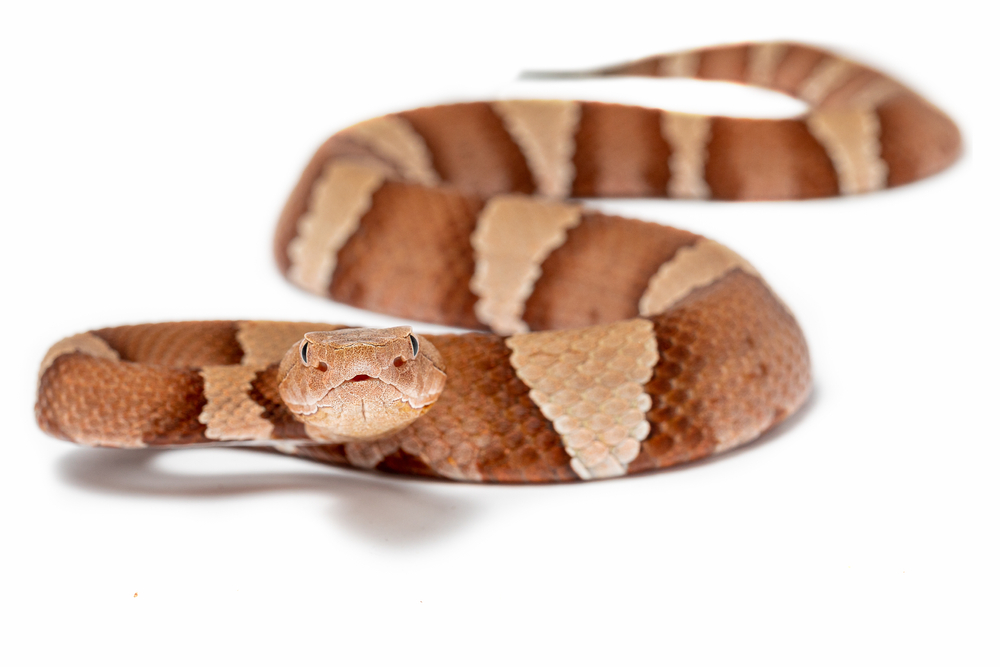
Cottonmouth or Water Moccasin
The next type of venomous snake in GA is the Cottonmouth or Water Moccasin. They are also dark brown or black but have much thicker bodies than copperheads. They also like being close to the water with wooden areas nearby.
Their signature move is to show off their wide white mouth when they feel in danger, which is where the name Cottonmouth came from.
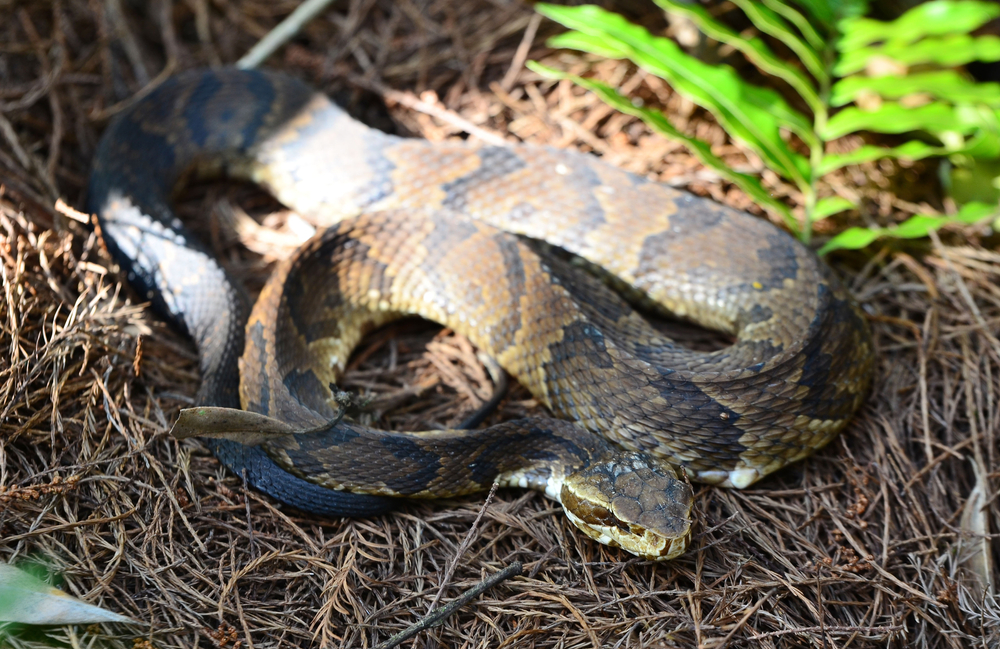
RattleSnakes
There are three different types of rattlesnakes in Georgia. The Eastern Diamondback the timber, and the pygmy rattlesnake.
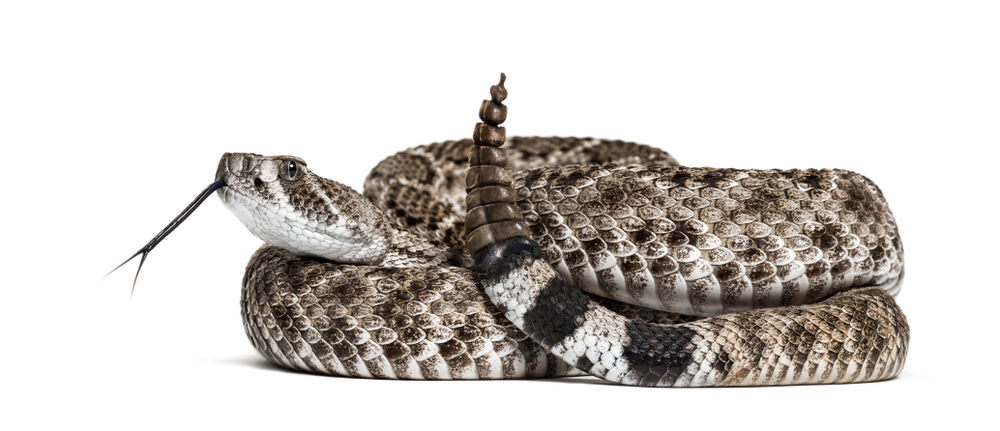
Eastern Diamondback Rattlesnake
The Eastern Diamondback is the largest venomous snake in North America and is known to grow up to 8 feet. It has a diamond-shaped pattern with a big rattle on the end of their tails. These rattlesnakes are found in southern Georgia and live near the coast.
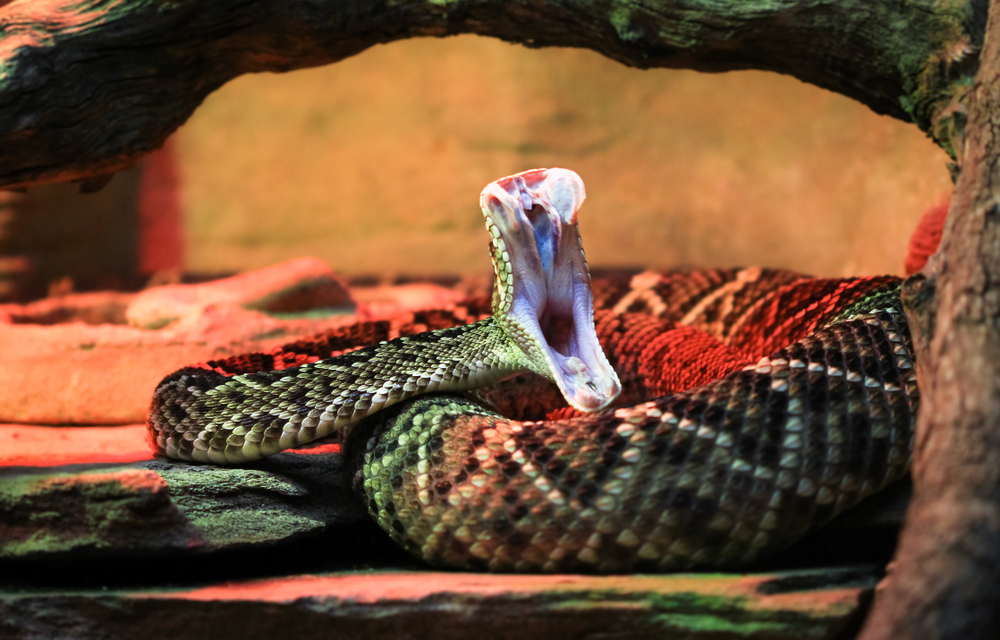
Timber Rattlesnake
The other type is the Timber Rattlesnake. This type of rattlesnake is long and heavy but only reaches 4 feet when they are fully grown. They have a grayish-brown body and also have a thick rattle on the bottom of their spine. They can be found mostly in Northern GA in the mountainous areas.
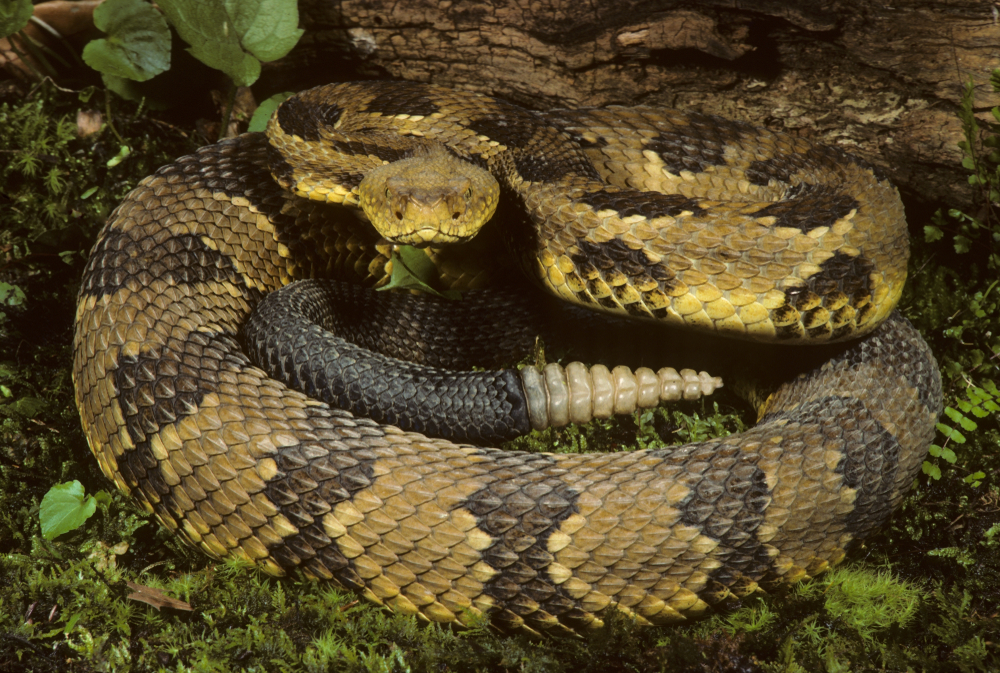
Pygmy Rattlesnake
Last but not least is the Pigmy rattler. They are the smallest rattlesnake reaching anywhere from 1-2 feet. Most of the time they are brown or gray in color with blotches of black or colorful spots along their back.
Pygmies can be found in wetlands like swamps and marshes, but have also been spotted in dense woodlands. They can be found throughout Georgia and are the least aggressive rattlesnake as they rarely bite humans, but as always leave them alone.
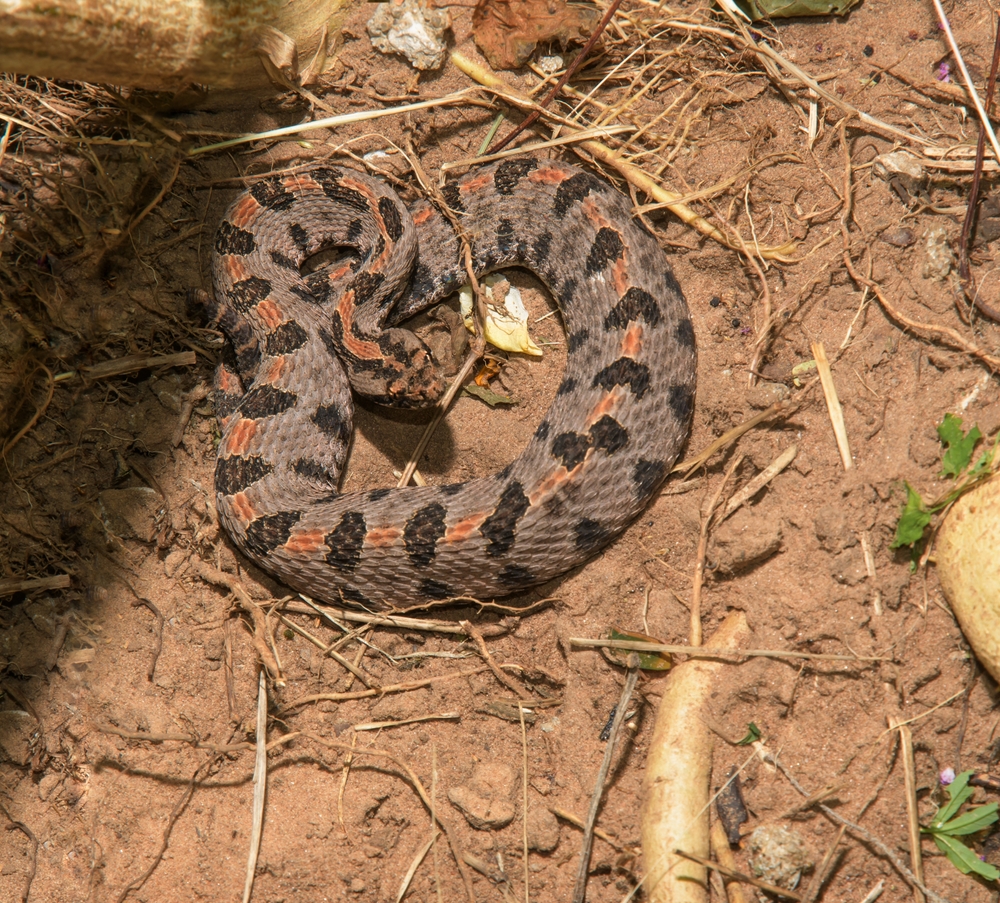
Coral Snakes
Up next is the Coral Snake and they are found throughout GA and the rest of the southeastern states as well. They are the easiest venomous snake to ID with their bright red and yellow bands.
That is also one of the easiest ways to tell if any snake is dangerous. If the red band touches the yellow band without a black in between then you want to stay far away from the snake. The bright colors are nature’s way of warning humans, and other animals, of danger.
Coral snakes in Georgia can be found statewide and have been known to set up home in neighborhoods, wetlands, and forests. They have been put on Georgia’s conservation list of endangered animals due to their habit loss in more recent years.
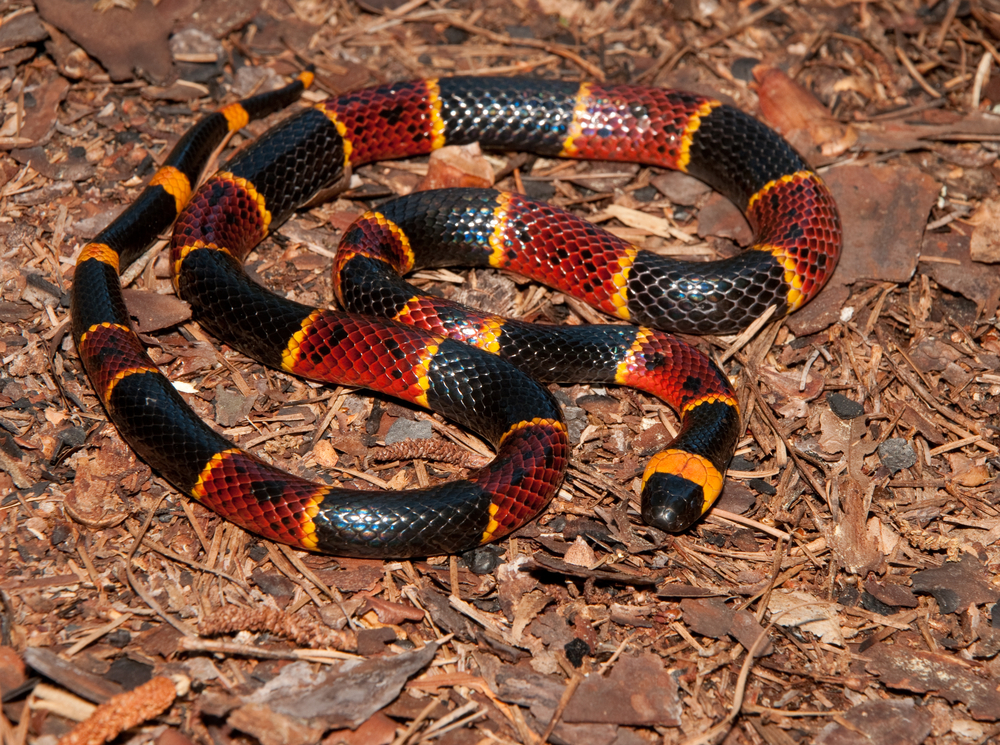
Non-Venomous Snakes in Texas
There are almost 40 non-venomous snakes in Georgia. Just because these snakes cannot hurt you does not mean you should ever mess with one. Snakes are an important part of the ecosystem and deserve to be left alone. For a longer list of the most common Georgia snakes in Georgia, check out the official information from the Georgia wildlife website.
Eastern Green Watersnake
First up is the Eastern Green Watersnake. These snakes are green or brown with dark bands across their bodies. They can grow to reach 4 feet in length and have thicker bodies than most other snakes in GA. They are mostly aquatic snakes and like to live in small rivers or ponds.
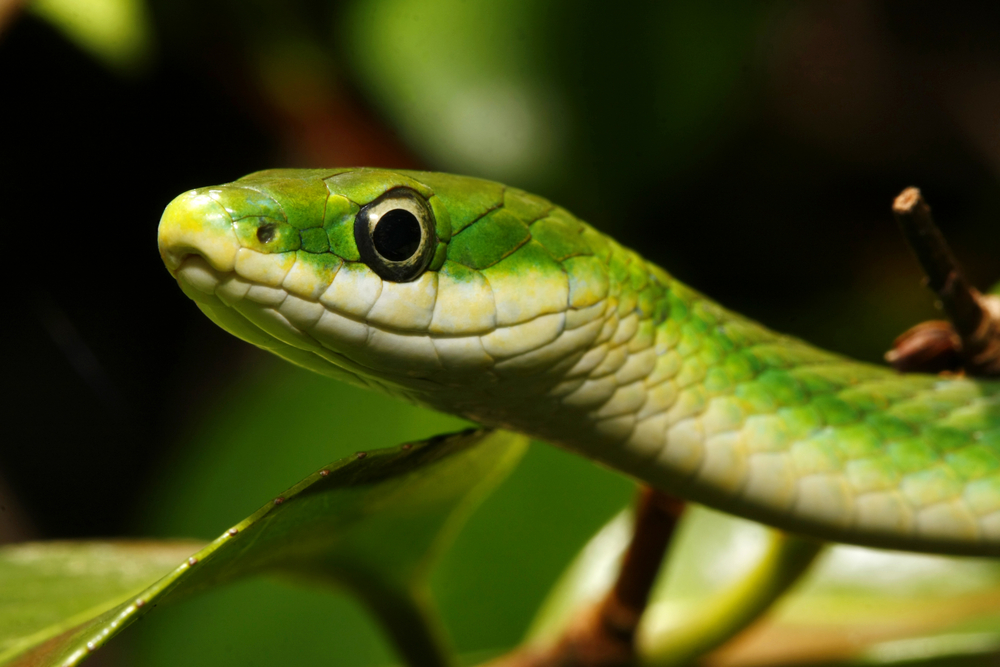
Brown Watersnake
Up next is the Brown Watersnake which likes to live in freshwater. They normally have a reddish-brown body and sometimes have black or brown dots. Be cautious because they can become aggressive if surprised but typically keep their distance in the water. The other types of water snakes include plain-bellied, banded, and northern watersnakes.
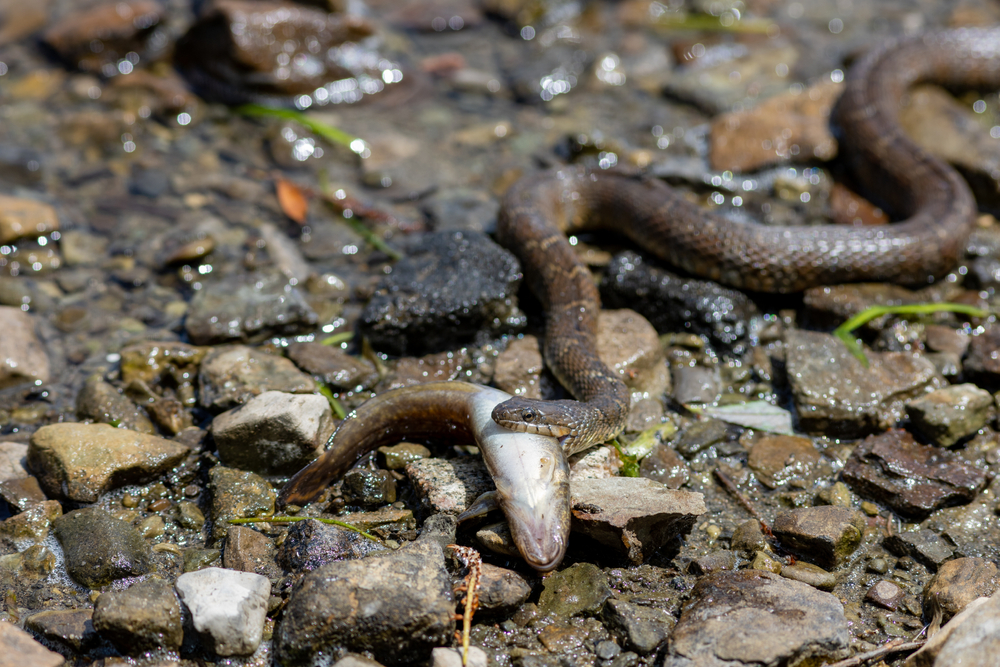
Queen Snake
Queen snakes are slender and come in a variety of light brown to gray colors. Their marking is unique and they will always have three yellow strips running down their dark backs. Primarily they are found in clean freshwater habitats like streams and small creeks. They especially love to hang out in bodies of water that have small rocks on the bottom.
They only like to eat crayfish but will change it up if they have to. You will most likely never see a queen snake because they are sneaky and very fast.
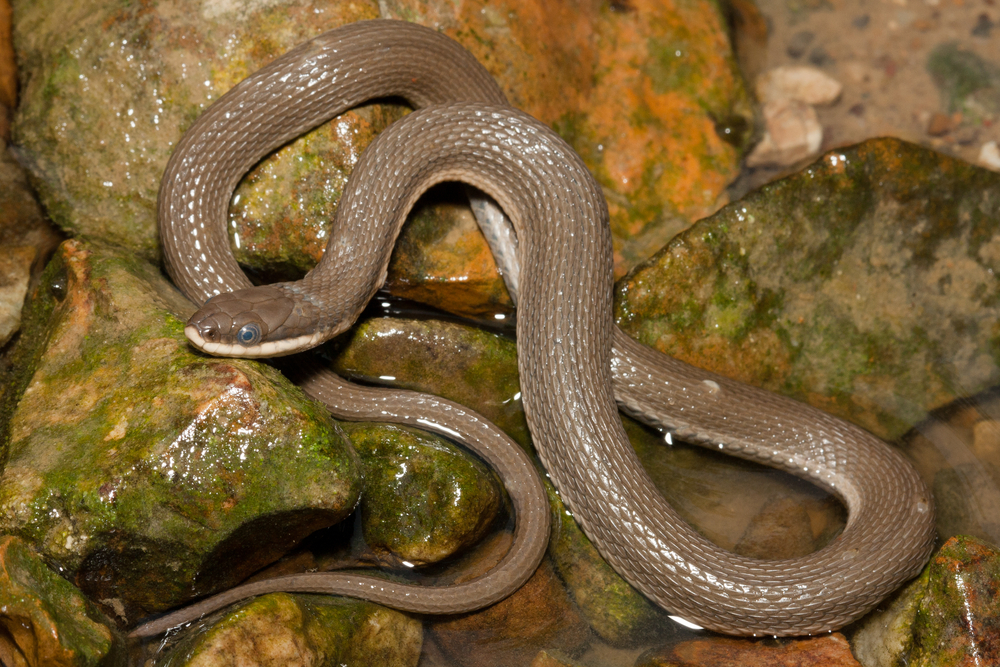
Black Swamp Snake
Up next is one of the most spotted black snakes in Georgia, known as the swamp snake. They are also found in freshwater throughout most of the southeastern states. Black Swamp snakes appear to shimmer a bit and are either black or brown.
They also have one of the smallest heads of all aquatic snakes in the area. You may see them sunbathing up on a rock if you are in a quiet area.
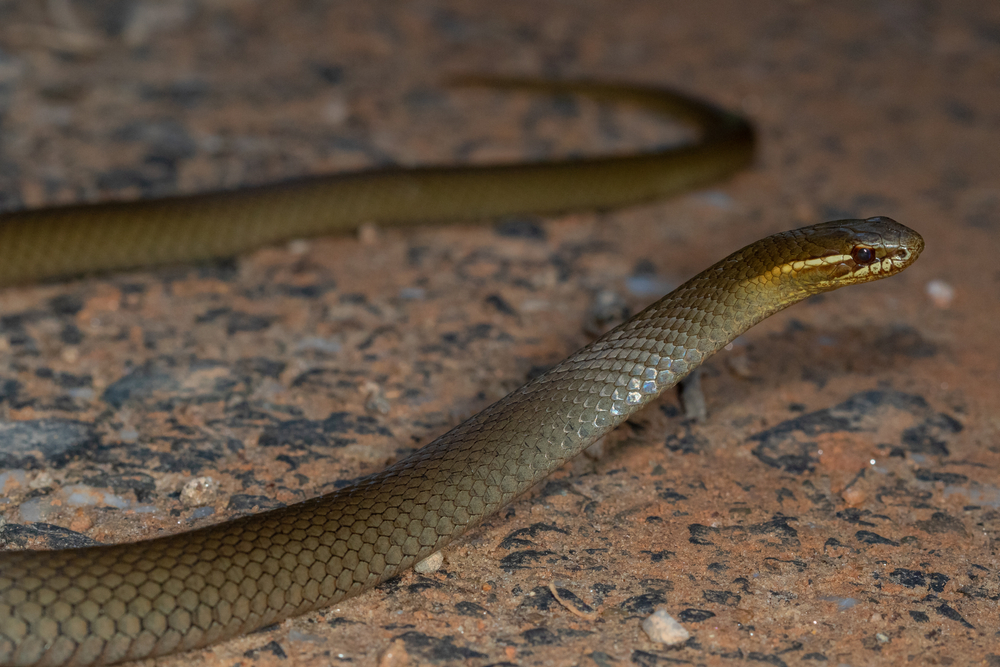
Red-bellied Snake
One of the most popular red and black snakes in Georgia is the red-bellied snake. This small non-venomous snake is in Georgia and can be found in many different kinds of habitats.
Their favorite place to be is anywhere with a shade like in fallen leaves or trees. For their appearance, they usually have a dark-colored back with bright red or orange bellies. And you would think because of the yellowish-red that they are dangerous, but in reality, they are very docile creatures.
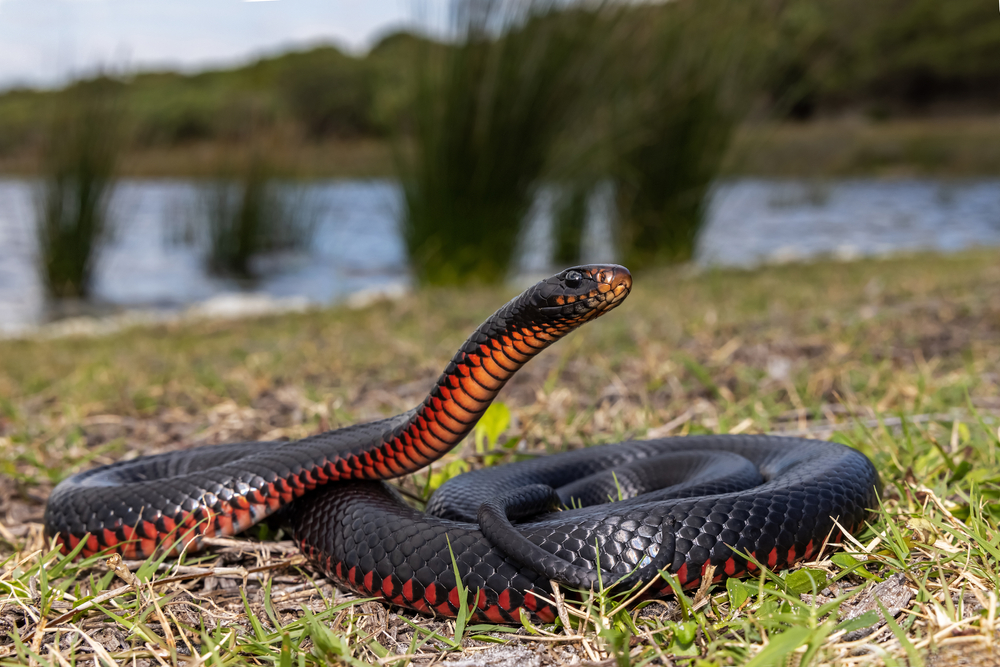
Eastern Ribbon Snake
The Eastern Ribbon Snake is one of the most spotted Georgia snakes with yellow stripes. These colorful snakes can grow up to 3 feet with thin bodies and pointy heads. They like living in the water with plenty of vegetation around where they can hide out from their prey.
They are another type of snake that loves to sunbathe and often set up for the day on rocks. When spotted they are quick in both the water and tree climbing. They are almost always harmless to people and very rarely attack.
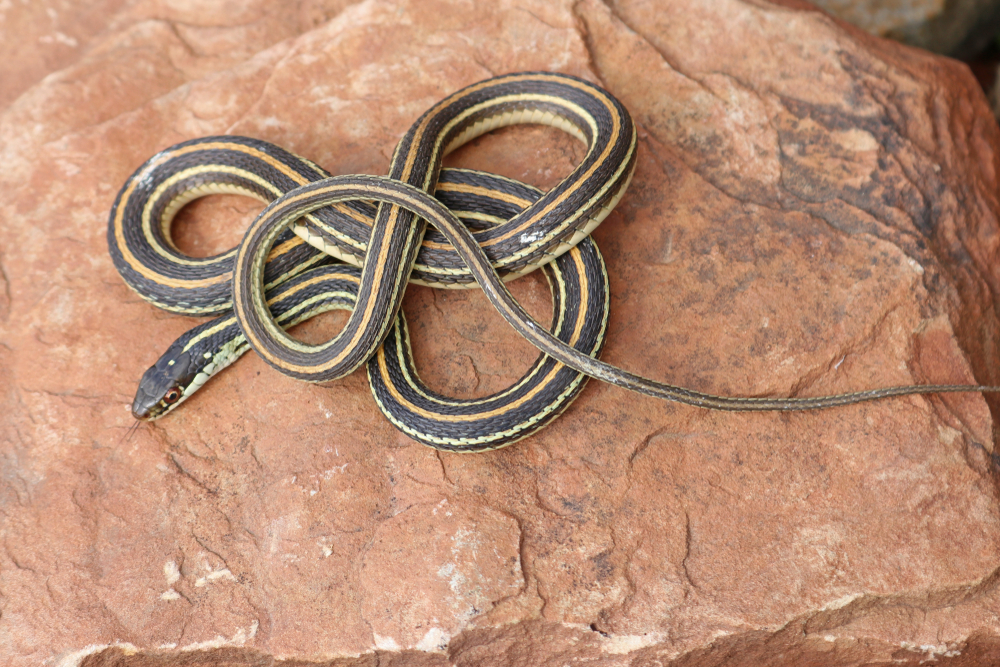
Common Garter Snake
One of the most common north Georgia snakes is the common garter. You will know almost immediately if you have found a garter due to its distinctive pattern of yellowish-green stripes down its back. They have been known to grow up to 4 feet, but are typically much smaller.
Garter snakes like to live in grassy areas like forests but have also been spotted in suburban areas as well. They also like having a freshwater source nearby and have been known to be in ponds.
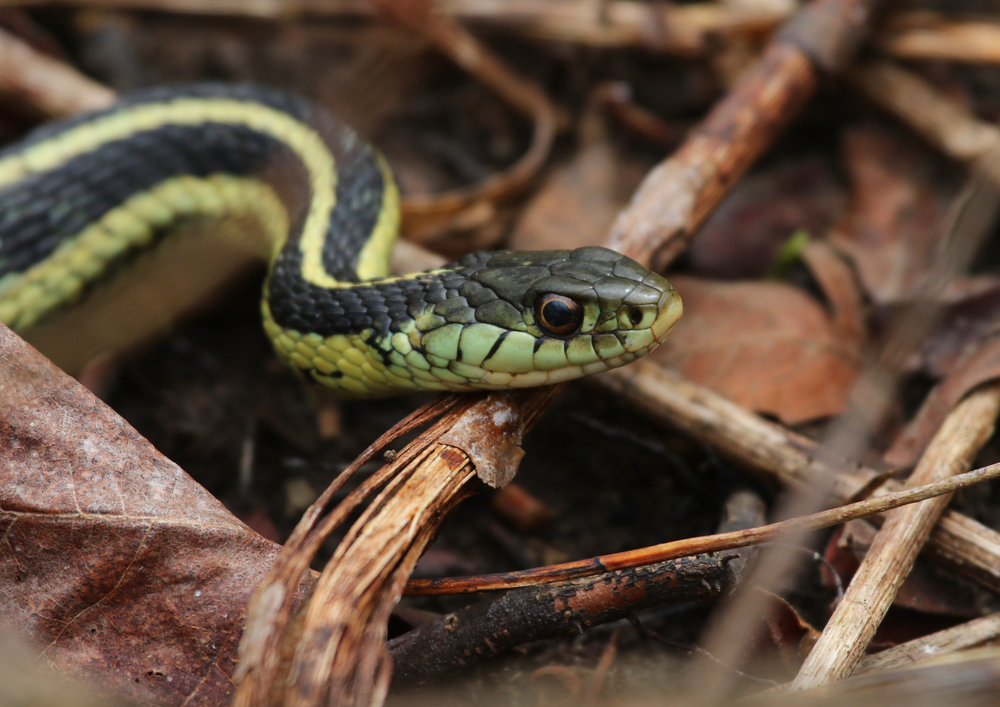
Common KingSnake
There are four different kinds of king snakes in Georgia. The common, black, scarlet, and common king snake. They all have white strips down their spine with colorful patterns in between.
The common king snake is spotted much more than the other Kingsnakes and they like to live in forests. They are one of the most popular snakes that collectors like to have as pets.
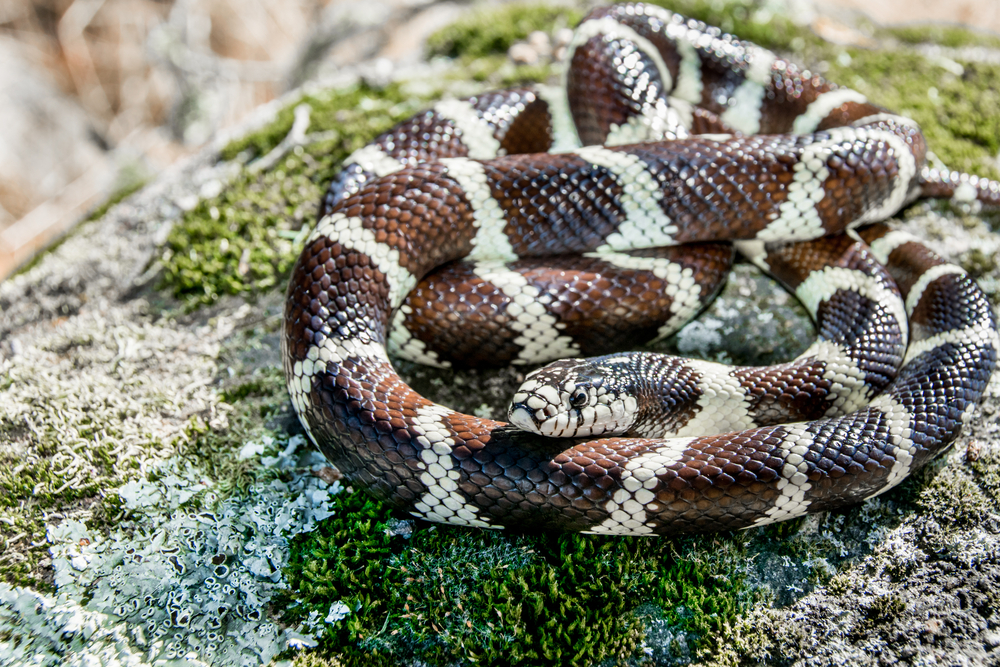

 15 Fun Things To Do With Kids In Houston You Must Visit
15 Fun Things To Do With Kids In Houston You Must Visit